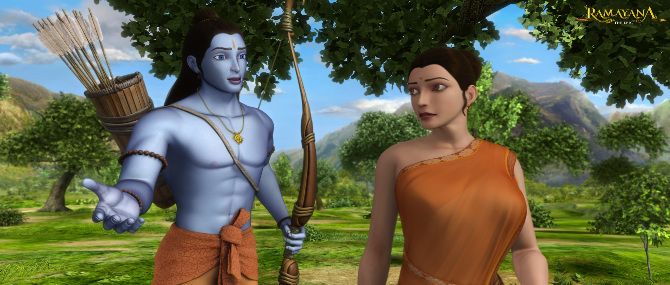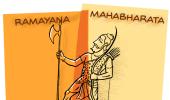'On as many as two occasions, Sita is called upon to take a test to establish her integrity and loyalty to Rama and on both the occasions she opts for a course of action on her own terms,' points out A K Bhattacharya, reviewing Bibek Debroy's translation of the Ramayana.

Bibek Debroy's translation of the Valmiki Ramayana in three volumes is the fifth such attempt at bringing before English readers the unabridged story of Rama, the king of Ayodhya, who vanquished Ravana, the demon king of Lanka, and reaffirmed the rule of dharma or, as some would like to believe, established the victory of good over evil.
Of the four previous attempts, only one could have been based on the Critical Edition of the Valmiki Ramayana produced by the Oriental Institute, Baroda from 1958 to 1975. The other three translations appeared well before all the volumes of the Critical Edition were available in 1975.
Debroy's is, thus, the second translation based on the Critical Edition, the first one being Robert P Goldman's rendering produced by Princeton University Press over a period of about 32 years from 1984 to 2016.
In contrast, Debroy's translation came out in a relatively short time. He took just about two years to translate 18,670 couplets, spread over 606 chapters under seven sections.
It is an effort for which Debroy deserves unqualified praise, especially because of the remarkably short time he has taken to translate the Valmiki Ramayana in simple language that is easy to understand.
Its accessibility is enhanced by the annotations in the form of footnotes across all the chapters, providing explanation for references to characters and incidents that otherwise would have made little sense to the lay reader.
Debroy explains that Ayana in Sanskrit means journey or progress and hence the Ramayana is the story of Rama's journey or progression.
It is significant that while explaining the meaning of the Ramayana, Debroy chooses to ignore the two other meanings of Ayana in Sanskrit -- mirror and treatise.
Arguably, therefore, the Ramayana could also be interpreted as the literary reproduction of Rama's life and exploits (like a mirror does) or a treatise on that values and principles that Rama stood for in his life.
But in all the three different interpretations of the Ramayana, the focus is necessarily on the principal character of Rama. And it is this focus on Rama that makes the Valmiki Ramayana a much more integrated epic. This also enriches the epic's narrative, making it tight and easy to follow.
Unlike the Mahabharata, where the narrative wanders into many other side stories, the central focus of the Ramayana is Rama and his exploits.
In that sense, the Ramayana is more faithful to the Aristotelian idea of unity of action than any other Indian epic.
If Debroy's translation of the Ramayana is easier to navigate, some credit should also go to its original creator, Valmiki, who stuck to a simple plot and tightly wove the different incidents into a unified action.
There is yet another area where the Valmiki Ramayana upholds the Aristotelian precept of deliberately removing suspense in the narrative to allow a more evolved critical appreciation of the characters and incidents in the epic.
Suspense blunts critical appreciation. But prior knowledge of the story line allows readers to critically evaluate the characters and the many twists in the plot that unfold in the succeeding chapters.
The Valmiki Ramayana narrates in brief the entire story of the epic in the first few chapters. The subsequent chapters are devoted only to the elucidation of the same ideas and the delineation of the plot that was briefly outlined in the first few chapters.
The Valmiki Ramayana also provides a clue to what could have been behind the creative inspirations of two of Bengal's poetic geniuses. Michael Madhusudan Dutt wrote an epic where he celebrated the valour and grit of Ravana's son, Meghnad.
Written in the late 19th century, the epic by Dutt questioned the manner in which Ravana's brother Vibhisana advised Lakshmana to attack Meghnad while he was worshipping.
The Valmiki Ramayana presents Meghnad as a great warrior, too. There is hardly any other member from the camp of Ravana, who receives such glowing tributes as does Meghnad.
Indeed, Meghnad's death is mourned by Valmiki in words that make you wonder on whose side the poet’s sympathies lie. A close reading of Debroy's translation makes it simply clear that Dutt's idea of celebrating Meghnad's heroism may well have germinated from the Valmiki Ramayana.
Similarly, Rabindranath Tagore's celebrated exposition on the distinction between poetic truth and historical truth seems to have drawn its inspiration from the Valmiki Ramayana.
Tagore had used the conversation between Valmiki and Narada (the sage who acted as a messenger for gods) to show how Rama as imagined by the poet would become more popular and timeless than the historical existence of the king of Ayodhya.
The Valmiki Ramayana endorses a similar theory.
Instead of Narada, it is Brahma who assures the poet of how his knowledge of Rama and how he chooses to portray him will surpass everything else.
'All that is unknown will also become known to you. In the Kavya you compose, not a single word will be false and there will be nothing that will not happen,' says Brahma.
The supremacy of poetic truth over historical truth is thus established.
The Valmiki Ramayana also dispels a myth that its composer was unfair to Sita, Rama's wife. Indeed, Valmiki has been quite sympathetic to Sita and forthright in taking exception to Rama's attitude to his wife.
After Ravana is killed, Rama asks Vibhishana to bring Sita before him. Vibhishana clears the place of all people so that the husband and wife can have a meeting in privacy.
But Rama admonishes Vibhishana and asks him to bring Sita in front of everybody present.
Valmiki writes: 'Thus addressed by Rama, the distressed Vibhishana humbly brought Sita to Rama's presence. Hearing Rama's words, Lakshmana, Sugriva and Hanumat were also extremely unhappy. They detected terrible signs in the way he was looking towards his wife. They debated that Raghava was unpleasant towards his wife.'
Valmiki's portrayal of Sita also shows that she is far more resolute in her actions than her popular image.
On as many as two occasions, Sita is called upon to take a test to establish her integrity and loyalty to Rama and on both the occasions she opts for a course of action on her own terms.
Eminent Indologist Wendy Doniger believed that Sita was a woman who made her choices with as much freedom as any other male character in the epic. Valmiki's Ramayana endorses this.
Conscious of her own commitment and inviolability, Sita gives Rama an opportunity to accept her as his wife.
Thus, the first time her character is questioned, Sita suitably frames her prayer before entering the fire: 'If my heart has always been with Raghava and never wavered, let the fire, which is a witness to the world, save me in every possible way.'
However, this attitude changes when her character is questioned for the second time.
This time she wants the earth to prove her integrity, but her condition changes.
Thus, she wants the earth to embrace her if she is found to be taint-free: 'If I have not thought of anyone other than Raghava in my mind, then let the goddess earth open up a chasm for me.'
This change in Sita's approach is significant and brings out the subtlety with which Valmiki portrays her character.
Sita is not always a victim of circumstances. She decides to live or die on her own terms.
The only quibble about Debroy's translation is his use of the word Hanumat to refer to Hanuman.
Debroy uses the rules of grammar to justify his decision. However, he is not consistent. Going by the same rule of grammar, Hanumat should be addressed as O Hanuman! and not as O Hanumat!











